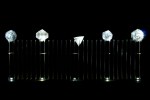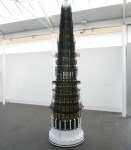Last week we opened the fourth exhibition in an annual commissioning series called Jerwood Makers Open. The project offers five significant commissions each year to early career artists whose work is concerned with craft and design, and it has an open, artist led brief. Artists propose a new body of work which they want to make and exhibit. We asked them to articulate what they would like to gain from the time, money and curatorial support that we can give. We present this project to the public through our contemporary art programme in London, and tour it around the UK.
Many of our other projects for visual artists create specific professional development opportunities too. These different configurations of time, resources and expertise acknowledge that as artists work with photography, or moving image, or ceramics, or textiles or across these, the challenges they face in making new work may be subtly different, and the kinds of supportive networks that they need to develop around their work may be different too.
Specialist experience does of course have its value and place, but only if we don’t ghettoise practice areas or artistic media in the process. Our world is still entrenched in categorisation at all levels of our lives and not least within a systematic global art world, but if the fluid attitudes of young people entering new professions today are anything to go by, these days of boundary, category and edge are, surely, numbered.
Art Close to Art: the status of the decorative arts today (Lisa Zeiger)
Jerwood Makers Open supports artists whose practice may be described as within the applied arts, or as craft, design, or art. These are artists who may work in glass whilst collaborating with scientists to explore complex theories, or who use their architectural training to create compelling story-worlds that are integral to their installation pieces.
Applied arts materials and processes have been both marginalised and fetishised at times within art history, sometimes even concurrently. There are vastly differing and complex value systems in operation around materials themselves. This in itself is fertile territory for artists, whatever their medium, just as it is when you consider painting’s history against that of photography, and what any work made in any form carries with it.
As technologies are constantly evolving along with the methods available for artistic expression, ideas of identity are also still on the move. This sense of fluidity began before my generation, with feminist theory and gender politics exposing the performativity of identity, and is amplified in the experiences of our first post-internet generation. In this context, can we really expect the same value systems around practice, material, process, or the same culturally instigated boundaries to hold fast?
If you were to ask me about the status of applied arts practice in the eyes of contemporary artists today, I would say that it is still a polarised area; you cannot cast off in one shrug the impact of centuries of tastemaking. But the generation coming up behind us already works naturally across disciplines, languages, across time and space even, and it is going to be a very different future.
Meanwhile, what remains important to us as a charitable foundation is that we are able to support skill, imagination and artists’ ideas. We will always need to begin somewhere, creating contexts in which that is possible, and in the hope that those contexts help to explode definitions just that little bit, not simply reinforce them.
‘Jerwood Makers Open’ is at the Jerwood Space, London until 31 August 2014.
Related Articles
Gallery: Jerwood Makers Open 2014
Art Close to Art: the status of the decorative arts today (Lisa Zeiger)







